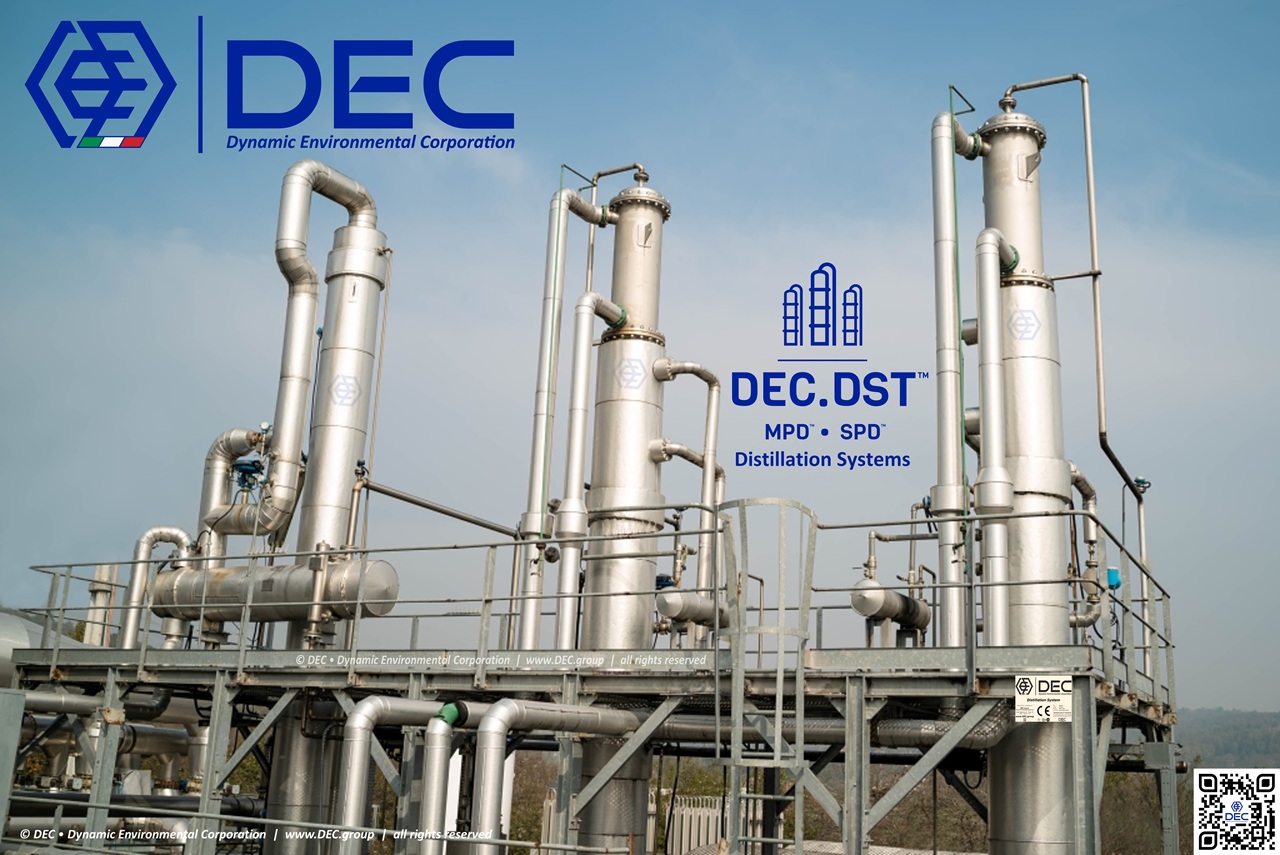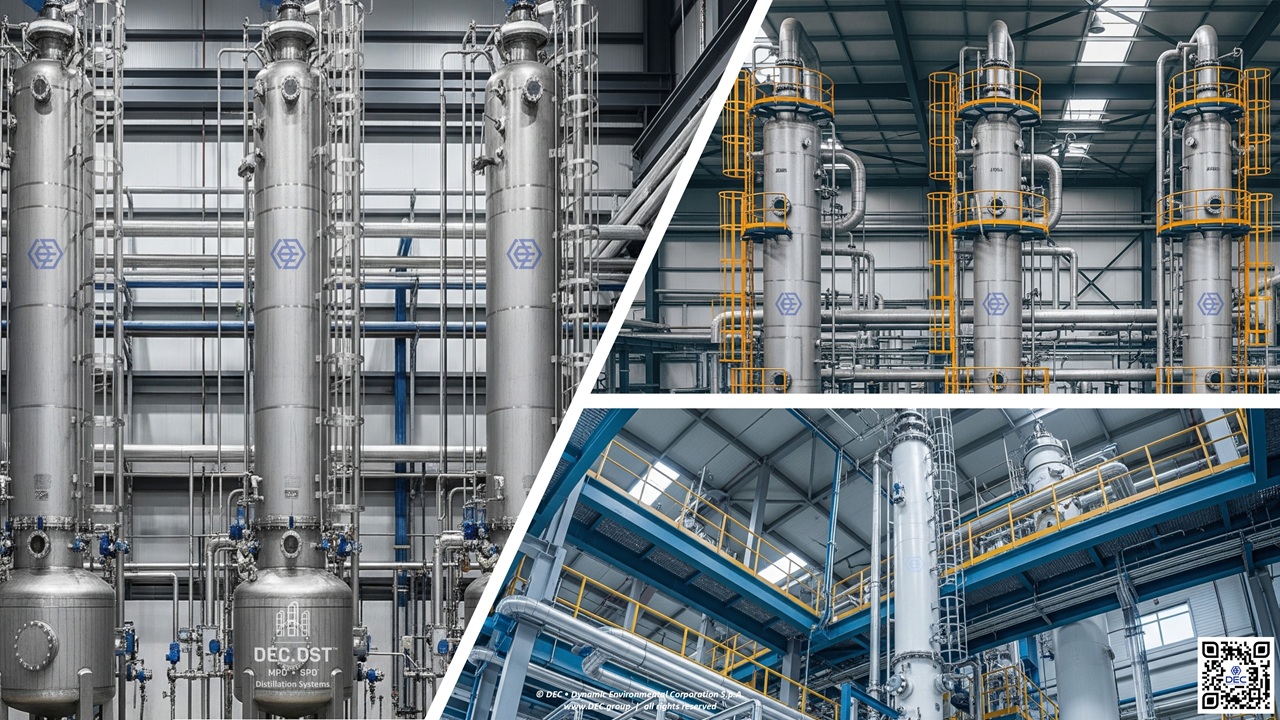
distillation systems for solvent recovery
DEC.DST™
Distillation is the most widely-used method of separating fluid mixtures on a commercial scale, it is thus an important part of many processes industries, including the packaging, chemical, oil and gas, and pharmaceutical sectors.
DEC.DST™ industrial solvent distillation systems are specifically designed to break down solvent mixtures into their individual components. This process allows for the recovery and reuse of valuable solvents, while also generating high-purity products for various applications.

Maximize your solvent recovery efficiency with our advanced distillation systems. We provide tailored solutions for industrial applications, focusing on optimizing column performance and ensuring high-purity product output. Whether you're seeking cost-effective systems for ethyl acetate or ethanol recovery from flexible packaging operations or need to troubleshoot existing units for azeotropes recovery in converting industries, our expertise ensures a seamless process. Discover how our energy-efficient distillation methods, coupled with our deep understanding of packed columns and fractional distillation, can significantly reduce your operational costs and environmental impact. Contact us for a customized solution and achieve substantial returns on your solvent recovery investment.
DEC.DST™ • distillation systems • batch (MPD™) | continuous (SPD™)
The distillation systems are coupled with the solvent recovery plants, in order to separate the mix of "raw" recovered solvents. If the solvents are soluble (totally or partially) with water, in order to increase the overall efficiency, the use of our DEC.ADM™ dehydration systems may be considered, so to remove the residual water content in the raw recovered solvent (coming from the humidity), before feeding the distillation plant.
DEC.DST™ • distillation systems | configuration
The following processes are available (stand-alone or multi-effect configuration):

DEC.DST™ • distillation systems | smart processes & technologies
When facing azeotropic mixtures (an azeotrope is a mixture of two or more compounds that cannot be separated or changed by simple distillation), different configurations of the distillation system shall be applied: some of the azeotropes require a change in the exercise pressure of the distillation system, known as pressure swing distillation (DEC.DST-p™ and/or DEC.DST-v™), while some require an additional solvent, an entrainer, known as extractive distillation (DEC.DST-e™): these processes are known as azeotropic distillation systems. When extractive distillation is the solution, the quantity, cost and availability of the entrainer should be considered. The solvent(s) should be easily separable from the entrainer, and should not react chemically with the components or the mixture fed to the distillation system. Traces of the entrainer, always remain in the distilled product, thus representing a contamination if the solvent shall comply with severe codes (i.e. food contact, tobacco, pharamceutical): in this case, extractive distillation shall not be considered as a valid option.
DEC.DST™ • Enhanced Approach to Distillation Process Optimization
Our approach to distillation process engineering transcends theoretical modeling, delivering tangible, real-world results. We leverage a powerful combination of:
This integrated approach, coupled with our extensive engineering expertise, empowers us to deliver "true and realistic" results, precisely tailored to each client's unique requirements.

DEC.DST™ • case-specific optimization and product quality
We understand that every distillation process is unique. Therefore, we conduct thorough, case-by-case analyses to determine optimal operating parameters, including:

DEC.DST™ • stringent product quality standards for direct reuse
Recognizing the critical importance of product quality for reuse in the productive cycle, we ensure that distilled products consistently meet stringent requirements:
By combining advanced simulation, experimental validation, and a deep understanding of distillation principles, we provide our clients with optimized solutions that deliver exceptional product quality and operational efficiency.

DEC.DST™ • LTKW
Dive deep into the nuances of solvent recovery distillation with our comprehensive resources. From "best distillation system for recovering normal propyl acetate from high boilings" to "designing a pilot plant for solvent recovery using fractional distillation," we cover every aspect. Learn "how to optimize distillation column efficiency for solvent recycling," explore "advantages of using packed columns in solvent recovery distillation," and understand "safety considerations when operating solvent recovery distillation equipment." If you're considering a purchase, we can help you with "selecting the right distillation system for recovering ethyl acetate from printing ink" or "buying used distillation systems for solvent recovery: pros and cons." For operational excellence, access our "maintenance and cleaning procedures for industrial solvent distillation systems" and stay updated on "latest innovations in distillation technology for solvent purification." Find "supplier of high-purity solvent recovery distillation systems," or a "reliable service provider for solvent recovery distillation system repairs." We also assist with "calculating the payback period for a solvent recovery distillation investment" and ensure "regulatory compliance for solvent emissions from distillation processes." Plus, explore "case studies of successful solvent recovery using distillation technology" and "comparing different types of packing materials for solvent recovery columns," leading to the perfect "customized distillation solutions for recovering mixed solvents in recycling plants."
